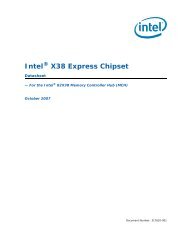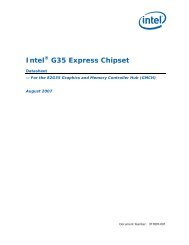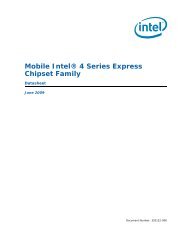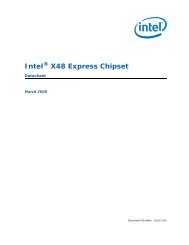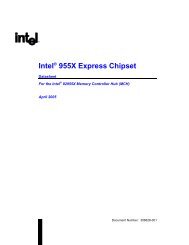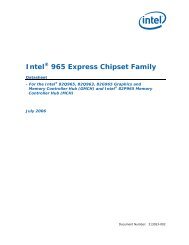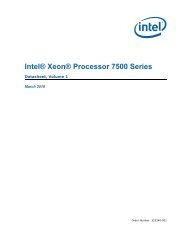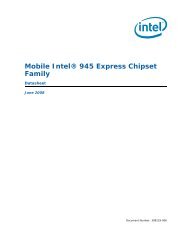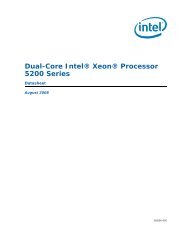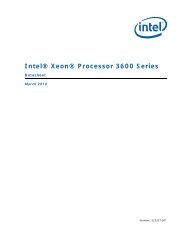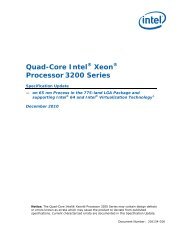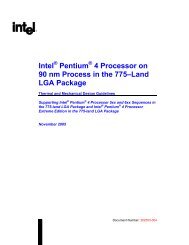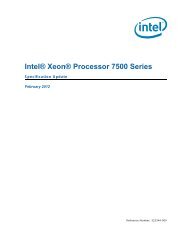Intel® 945G/945GZ/945GC/ 945P/945PL Express Chipset Family ...
Intel® 945G/945GZ/945GC/ 945P/945PL Express Chipset Family ...
Intel® 945G/945GZ/945GC/ 945P/945PL Express Chipset Family ...
Create successful ePaper yourself
Turn your PDF publications into a flip-book with our unique Google optimized e-Paper software.
Functional Description<br />
10.5.5.2 Combining Intrinsic and Specular Color Components<br />
The GMCH allows an independently specified and interpolated “specular RGB” attribute to be<br />
added to the post-texture blended pixel color. This feature provides a full RGB specular highlight<br />
to be applied to a textured surface, permitting a high quality reflective colored lighting effect not<br />
available in devices that apply texture after the lighting components have been combined. If<br />
specular-add state variable is disabled, only the resultant colors from the map blending are used.<br />
If this state variable is enabled, RGB values from the output of the map blending are added to<br />
values for RS, GS, and BS on a component by component basis.<br />
10.5.5.3 Color Shading Modes<br />
The raster engine supports the flat and Gouraud shading modes. These shading modes are<br />
programmed by the appropriate state variables issued through the command stream.<br />
Flat shading is performed by smoothly interpolating the vertex intrinsic color components (Red,<br />
Green, Blue), Specular Highlights (R,G,B), Fog, and Alpha to the pixel, where each vertex color<br />
has the same value. The setup engine substitutes one of the vertex’s attribute values for the other<br />
two vertices attribute values thereby creating the correct flat shading terms. This condition is set<br />
up by the appropriate state variables issued prior to rendering the primitive.<br />
OpenGL and D3D use a different vertex to select the flat shaded color. This vertex is defined as<br />
the “provoking vertex”. In the case of strips/fans, after the first triangle, attributes on every vertex<br />
that define a primitive are used to select the flat color of the primitive. A state variable is used to<br />
select the “flat color” prior to rendering the primitive.<br />
Gouraud shading is performed by smoothly interpolating the vertex intrinsic color components<br />
(Red, Green, Blue). Specular Highlights (R,G,B), Fog, and Alpha to the pixel, where each vertex<br />
color has a different value.<br />
All the attributes can be selected independently from one of the shading modes by setting the<br />
appropriate value state variables.<br />
10.5.5.4 Color Dithering<br />
Color dithering helps to hide color quantization errors. Color dithering takes advantage of the<br />
human eye’s propensity to “average” the colors in a small area. Input color, alpha, and fog<br />
components are converted from 8-bit components to 5- or 6- bit components by dithering.<br />
Dithering is performed on blended textured pixels. In 32-bit mode, dithering is not performed on<br />
the components.<br />
10.5.5.5 Vertex and Per Pixel Fogging<br />
Fogging is used to create atmospheric effects (such as low visibility conditions in flight simulator-<br />
type games). It adds another level of realism to computer-generated scenes. Fog can be used for<br />
depth cueing or hiding distant objects. With fog, distant objects can be rendered with fewer<br />
details (fewer polygons); thereby, improving the rendering speed or frame rate. Fog is simulated<br />
by attenuating the color of an object with the fog color as a function of distance. The higher the<br />
density the lower the visibility for distant objects.<br />
There are two ways to implement the fogging technique: per-vertex (linear) fogging and per-pixel<br />
(non-linear) fogging. The per-vertex method interpolates the fog value at the vertices of a polygon<br />
246



